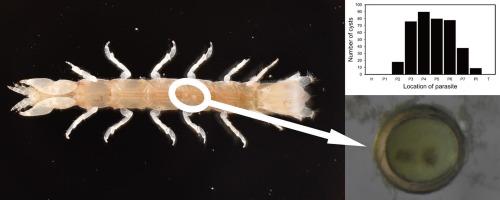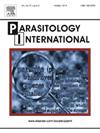Trematode metacercariae parasitic in the estuarine crustacean Cyathura muromiensis Nunomura, 1974 (Peracarida: Isopoda: Anthuroidea)
IF 1.5
4区 医学
Q3 PARASITOLOGY
引用次数: 0
Abstract
This is the first report of trematodes parasitic in the estuarine isopod crustacean Cyathura muromiensis, and the fourth report from anthuroid isopods worldwide. From 52 of 54 host individuals collected qualitatively on the tidal flat of the Muromi River estuary, Fukuoka, Japan, 389 cysts of metacercariae were extracted (sample prevalence = 96.3 %). Host individuals contained from one to 71 metacercarial cysts. The range in cyst diameter was 172.3–252.1 μm, and the distribution of cyst sizes contained only one component. Cysts occurred in pereonites 2–7 and the pleon of the host, but not in the head, pereonite 1, or telson. There was no correlation between the number of cysts and host sex or size. Sequences of the nuclear “ITS1 region,” from the 3´ region of 18S rRNA to the 5´ region of internal transcribed spacer I gene (ITS1), from five cysts ranging in size from nearly the lowest diameter to the greatest diameter in our sample showed p-distances of 0.0–0.2 %, suggesting that all cysts obtained were conspecific. A phylogenetic reconstruction based on nuclear 28S rRNA gene sequences showed that the trematode belongs in the genus Microphallus. The definitive host of our trematode species is likely a bird, since the definitive hosts of microphallids are chiefly birds, and birds are known to prey on Cyathura isopods.

寄生于河口甲壳类 Cyathura muromiensis Nunomura 中的变形虫,1974 年(Peracarida: Isopoda: Anthuroidea)。
这是关于河口等足类甲壳动物Cyathura muromiensis体内寄生有吸虫的首次报道,也是全球范围内关于等足类甲壳动物体内寄生有吸虫的第四次报道。从日本福冈县室见河口潮滩上采集的 54 个寄主个体中的 52 个个体中,定性提取了 389 个包囊(样本流行率 = 96.3 %)。寄主个体含有 1 到 71 个蛔虫包囊。囊肿直径范围为 172.3-252.1 μm,囊肿大小分布只包含一个成分。囊肿出现在寄主的第 2-7 节围虫和胸膜上,但不出现在头部、第 1 节围虫或尾柄上。包囊的数量与宿主的性别或体型没有相关性。从 18S rRNA 的 3´ 区域到内部转录间隔 I 基因(ITS1)的 5´ 区域的核 "ITS1 区域 "序列显示,p-差异为 0.0-0.2 %,表明所获得的所有囊虫都是同种的。根据核 28S rRNA 基因序列进行的系统发育重建显示,该吸虫属于微囊虫属。我们的吸虫物种的最终宿主很可能是鸟类,因为小球藻的最终宿主主要是鸟类,而已知鸟类会捕食Cyathura等脚类动物。
本文章由计算机程序翻译,如有差异,请以英文原文为准。
求助全文
约1分钟内获得全文
求助全文
来源期刊

Parasitology International
医学-寄生虫学
CiteScore
4.00
自引率
10.50%
发文量
140
审稿时长
61 days
期刊介绍:
Parasitology International provides a medium for rapid, carefully reviewed publications in the field of human and animal parasitology. Original papers, rapid communications, and original case reports from all geographical areas and covering all parasitological disciplines, including structure, immunology, cell biology, biochemistry, molecular biology, and systematics, may be submitted. Reviews on recent developments are invited regularly, but suggestions in this respect are welcome. Letters to the Editor commenting on any aspect of the Journal are also welcome.
 求助内容:
求助内容: 应助结果提醒方式:
应助结果提醒方式:


